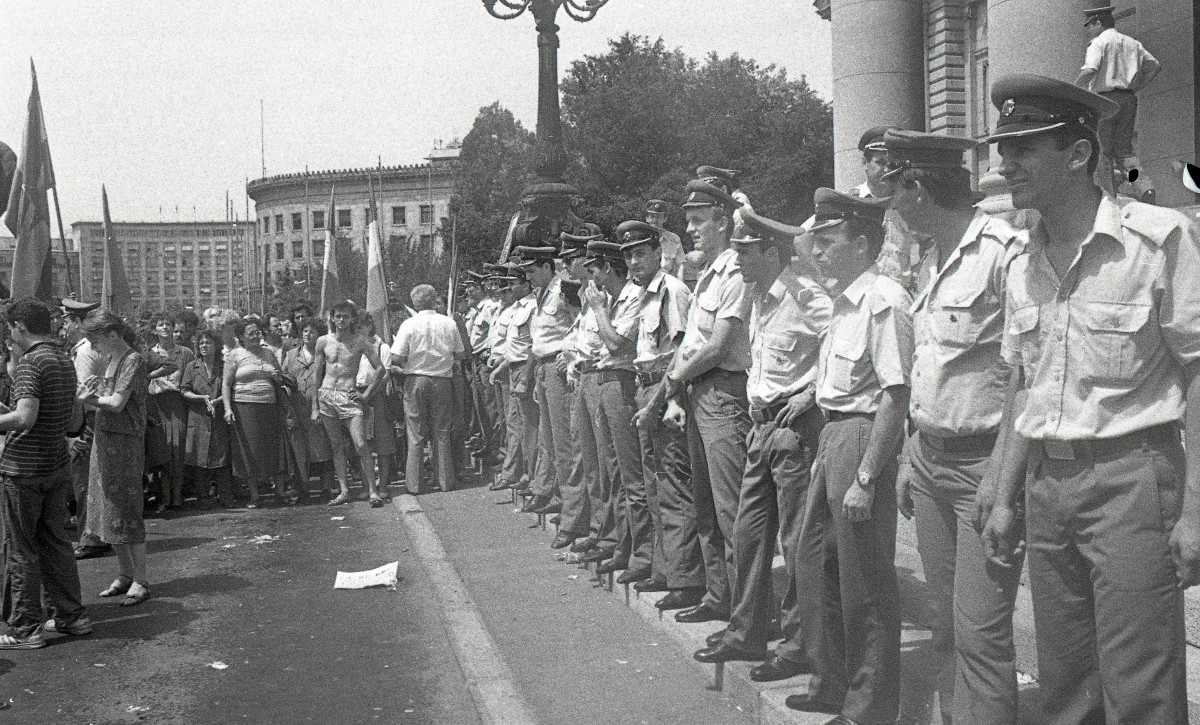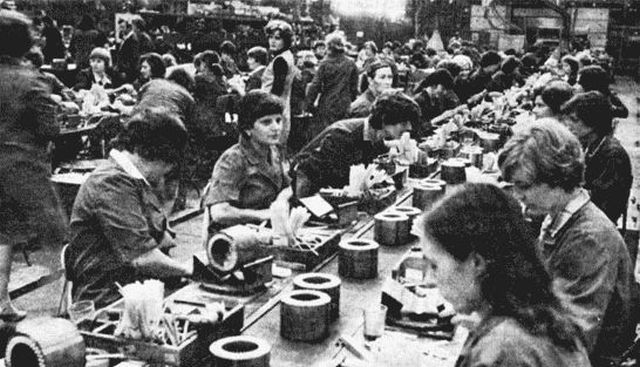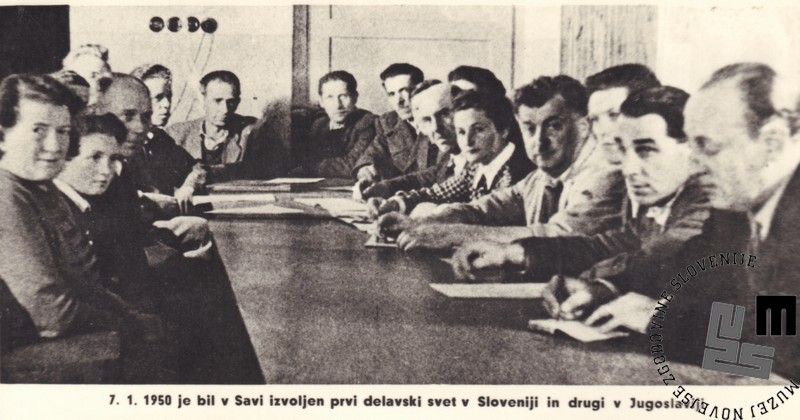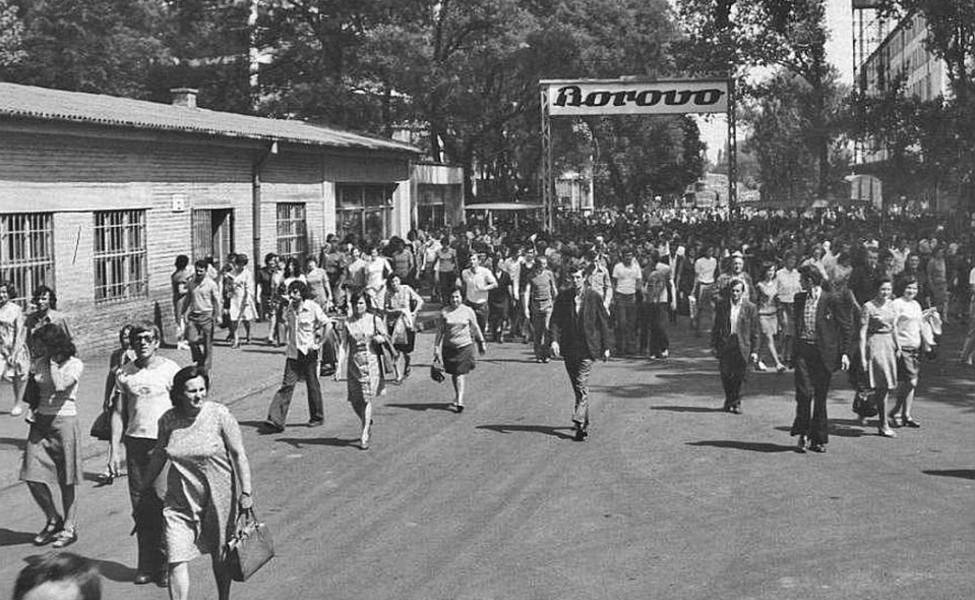
Lila
It was probably because of the system of self-management why I became particularly interested in Yugoslavia and its successor states. Coming from a western country, workers self-management which characterized the Yugoslav economic reproduction seemed amazing to me. Workers should have had most of the power in every factory and the whole economy, as well as the local administration, was organized like this. Direct democracy in practice, workers decide about their fate – impressive. Living for several years in Ex-Yugoslavia, reading more about self-management and talking with (former) workers about their experience certainly changed my picture. Without a doubt, self-management did not live up to its expectations.
In the following text, I want to trace the idea and the development of Yugoslav self-management during the time of the “real existing socialism” and add a perspective of workers, which I got through discussing the topic with them. I believe that workers had better working conditions and officially more rights to influence the decision making in the factory in comparison to the situation of workers in western capitalist and eastern “communist” countries during that time; or, if we compare, it was certainly much better than their situation today in the Ex-Yugoslavian countries. Nevertheless, the system of workers’ self-management was still a system that reproduced hierarchical and class-relations, similar to the ones in capitalist states or in socialism. When we talk about the Yugoslav system of workers’ self-management, it has to be remarked that it was in constant change and development during its four decades of existence. Its’ architecture inside factories and its embedment into the economic system underwent perpetual transformations. Beyond that, the ideological foundation of Yugoslavia, the influence of the State, in and outside of the factories, as well as the impact of a gradual liberalizing economy, are essential to understanding workers self-management.

Workers self-management in Yugoslavia came to life after the Second World War. With the take-over of power by the Communist Party of Yugoslavia1, the economic transformation of Yugoslavia was initially oriented on the model of the Soviet Union. The nationalization of private property was introduced, later seen as the precondition for self-management. Nevertheless, Yugoslavian political elites neglected the role Stalin anticipated for Yugoslavia. A “third way”, the countries self-positioning between the socialist and the capitalist blocks, was the outcome of this discontent between the Soviet and the Yugoslav leaders. Yugoslav political elites presented workers self-management as a specific model to distinguish oneself from the Soviet Union, while moving closer to the West. In Yugoslav propaganda workers self-management was presented as a consequence of the break-up between Tito and Stalin in 1948, but built up on the experiences of Second World War, during which the Partisans practiced some kind of self-management in the liberated areas. Criticizing the Soviet model as bureaucratic, the system of self-management was introduced as the “true” implementation of Marxist and Leninist principles. While companies in state-ownership were seen as hierarchically organized and fully penetrated by the State, self-management was shown as a step towards the “withering away of the State”. It was, therefore, the “true” way to socialism. In 1963, state property was transformed into social property – a construct of property that belonged to “everybody and nobody” or to the “working people”. By seeing state property and private property as obsolete forms, social property was supposed to belong to the society as a whole. Nevertheless, the overall goal was the modernization of the society and the economy with the normative goal of an industrial development in a workers society.2
Through time, workers’ decision making rights on the normative level were increased in the factories. Beyond that, the influence of the State was slowly reduced, while market mechanisms were gradually extended. In 1952, central planning by the State concerning buying and selling was annulled. It was left to every factory where to purchase and to sell their goods, depending on their abilities and economic performance. Also in the beginning, nearly 95% of the investments was controlled by the State, in 1961 the workers’ collective had most of the authority over their investments. This aspect and the introduction of individual wages in each factory had a big influence on the inequality of workers. Workers were now paid according to the “result of their work”. Even though wage differences did not develop much in the same factory, they emerged between different branches or even on a national scale.3 Therefore, the system enforced on one side the competition between the workers collectives, while on the other side there was also a competition between workers for higher paid jobs.4 Factories in more profitable branches could pay higher wages, while in unprofitable and State-subsidized factories the wages were generally low. While some workers could not even pay for their daily expenses others could live a decent life. It was in addition common that a part of the workforce was employed for seasonal work or had a short term working contract, as it was in the interest of the factory to create profits.

The political elites answered to the decline in production and the high trade balance deficit in the beginning of the 1960s with a further liberalization of the Yugoslav economy. Especially through the economic reforms in 1964 many banks were given the rights to grant capital investments, taxes on profits were reduced, foreign investment into Yugoslavia was allowed and many prices were not set anymore by State authorities. A year later, the reduction of trade barriers were aimed to promote foreign trade so that Yugoslavia could position itself within the world market. However, the expectations of prosperity were not met. On the contrary: foreign imports flooded the country, economic performance declined and unemployment became a rising problem. As a consequence many unemployed left the country. With the new constitution in 1974, the fragmentation of Yugoslavia became even more institutionalized. Depending again on cheap western credits, foreign imports increased gradually. As a consequence of the oil-price shock in the end of the 1970s, interest rates rose. Yugoslavia found itself in a tremendous crisis. The World Bank and the International Monetary Fond pressured Yugoslavia into austerity measures. Many workers lost their jobs, salaries were frozen or tied to the productivity of the factory. A high inflation rate led to the impoverishment of a large part of the society. The dissatisfaction with the economic situation brought many workers to the streets. While at the end of the 1980s social demands were articulated, later the support for the Socialist Party of Serbia under Slobodan Milošević with its nationalist program was in the center of workers protests in Serbia, which were called the Anti-bureaucratic Revolution.5
One consequence of the “socialist” economy that used capitalist means were regional differences, which influenced the dissolution of Yugoslavia in the 1990s. The northern republics of Croatia and Slovenia were more wealthy, while the southern region of Bosnia-Herzegovina and the autonomous region of Kosovo belonged to the poorest. It was in the interest of the republics – as their received revenues from the companies – that profits would be kept there. Even though the State established programs of capital distribution to poorer regions, large differences in terms of industrialization, investments and unemployment developed. This gap was never shut, but even developed further during the years. While in Slovenia the national product per capita in 1951 was 170% above the Yugoslav average, in 1981 it rose to 198%. In Kosovo, during the same period these numbers declined. In 1951, Kosovo national product per capital was 44,1% of the Yugoslav average while thirty years later just 30%.6 An equal development amongst the different regions was therefore not achieved.

Having a closer look at workers’ self-management on the shop-floor, the constant re-modeling of its’ structures and ideological underpinning are an attribute that characterizes the system. Introduced in 1950, workers’ self-management was closely linked to the State. Even though this system was imposed from “above” and not fought by workers in social struggles, it has to be noted that it was influenced by trade unions coming from the shop floor.7 Workers’ councils, elected by the workforce of every factory, were introduced in each factory and had initially an advisory function to the general manager. The director was imposed by State officials and had still most of the power in the factory. He8 could use a veto against the decisions of the workers’ council. As Unkovski-Korica noted, the Yugoslav elites imposed self-management not just to position oneself between the two blocks, but also to push back wage claims of workers. Besides, they were satisfied with the first results of self-managed factories as it increased productivity.9 In 1965 the law changed. Directors were now elected by the workers’ collective for four years and were under the directive of the workers’ council. Therefore, the workers’ council was supposed to be the highest decision making organ in the factories with most of the power. Even though the workers’ collectives had now the possibility to select between different candidates for the appointment of the director, he had to be a member of the League of Communists. In 1976, the system of workers’ self-management was again largely changed. With the introduction of smaller administrative units, the so-called “Basic Organizations of Associated Labor” (Osnovne organizacije udruženog rada), the influence of workers on decisions should have been increased. Smaller units of large sized factories were now split and set to perform as individual entities. Through contracts, factories were supposed to negotiate about their production with other companies which was intended to ensure the control of economic system by the workers. This system never really lived-up to its expectations.
The participation of workers in the self-management factories during the four decades of workers self-management changed within its’ development. It was mostly in the 1960, that workers were actively participating. The number of meetings of the workers councils was high (24,3 meetings per year) and each meeting lasted about three to four hours. Afterwards, the number decreased as well as the attendance of the workers. It even further declined in the 1970s and 1980s. In the beginning, workers discussed the functioning and organization of self-management. It was of everyone’s interest to figure out how to make the system work. There was also a kind of sense of belonging induced by self-management mechanisms that fostered participation. Later, the working conditions and the living situation of workers, salaries or the investment into the factories capacities were frequent topics in workers councils. Yugoslav scholars explained the drop in participation with a kind of adjustment to the system.10 But it was also the experience of disillusionment that workers encountered in the factories. The promises of a system of workers control in the factories were never fulfilled. It was mostly the management and directors who were actively participating in the meetings of the workers councils and directly and/or indirectly decided about the development of the factory. This trend was even more visible during the 1960s, when business knowledge was more valued. Beyond, managers and directors had most of the information, so a knowledge hierarchy influenced the decision making in the factories. Scholars emphasized that workers on the shop floor – mostly in the beginning after the installment of workers self-management – did not have access to education and therefore did not have knowledge about their rights. Furthermore, they were used to a patriarchal system of decision making. For women, workers’ self-management was not – similar to other areas of social life – a place for emancipation. Even though women had a higher rate of employment than in capitalist countries, it was mostly men who were elected in the workers councils.11 On one side, because women experienced a kind of “triple burden” of labor, participation in decision making and reproductive labor. On the other side, male networks were present in factories. Besides, women were less represented in higher positions in the factory. At the end of the 1970s, around 6% of general managers in factories were women, while in 1987 this number slightly rose to 6,43%.12

Talking to workers who experienced self-management in factories at the end of the 1980s, they mostly expressed disillusionment about the functionality of the system. Many explained that decisions in the factories were made by the general managers who were influenced by the League of Communists. They stressedth at the decisions were not made in the workers councils, but “somewhere else”. Sociological accounts on the question mostly coincide with what workers remembered. Members of the League of Communists had most of the power in factories. They made a significant part of the management.13 This does not seem to be a paradox, as the membership was nearly for everybody a precondition for a higher position in the factory. Nevertheless, the relation between managers and the political elites did seem conflictive. While managers criticized the system as ineffective, decision making would take too long and legal rights would have been insecure, political elites feared the influence of successful managers, as they were in a position of power.14
The “socialist” system of workers self-management was, therefore, filled with contradictions and could not live up to promises made by the Socialist elites. These discrepancies came to light through the high numbers of strikes. Within the normative framework of self-management, strikes were seen as highly contradictory within a system where workers decided about their fate and had the power: “Workers cannot strike against themselves.” But even though strikes were not forbidden, but also not allowed in Yugoslavia, they were mostly neglected in the public discourse. From 1958 until 1969 already 2000 strikes occurred. Afterwards, this trend did not decline. Around an average of 150 workers were involved in a strike.15 As Jovanov stresses, workers were mostly unsatisfied with their wages, or in minor cases felt a kind of dissatisfaction with how their work was valued. Moreover, they criticized their minor position in the economic or public sphere and their influence on political decisions. It seems also interesting that these strikes lasted mostly not longer than one day. The political elite had an interest in quickly ending them. As they were seen as contradictory to the system of workers self-management, a public discussion would challenge the system. Therefore, workers demands were quickly fulfilled. Some of the workers, however, feared being labeled as a “politicaly suspicious worker” and were therefore afraid of strikes in general or had an interest in quickly ending them.16
The strikes in general could also be seen as an indicator for the class division within the Yugoslav society: mainly workers in the production sector showed their discomfort, while workers with a better social status, workers in banks, public administration, or in foreign trade companies, did not tend to strike. It was not just wages but also other forms of economic discrimination workers in the production sector experienced. One example is the access to housing. Housing was a right for every worker and should have been implemented by the company. However, workers on the shop floor mostly waited longer for a flat or a housing loan than e.g. workers in public administration.17 Also, managers and other higher skilled workers within a factory had privileged access. Even though a system was installed which should favor workers in need, this was not always fulfilled in practice. It was mainly argued that the labor of higher skill workers seemed more important for the success of the factory and therefore they should be granted with better working and living conditions.18
Today there is not much left of workers’ self-management. Workers talk disappointedly about the self-management aspects of the Yugoslav system. Even though workers positively emphasize the welfare system, which was also granted by the factory and the former more comradely atmosphere on the shop-floor, they did not feel like the ones who decided in the factory. At the end of the 1980s, public discourse about workers’ self-management changed. It was seen as one of the causes for the economic crisis. Workers were blamed for not working efficiently enough, because it was hard to dismiss them from their job, or they were presented as lazy or stealing from their workplaces. Also, workers experienced a decline in their living conditions due to the crises. This was – as well – one of the reasons why they welcomed the privatization of “their” factory, which meant at the same time a decline of their formal decision making rights. The media and political elites presented privatization of the socially owned factories as a means for achieving better working results and therefore higher wages. Even though workers today think differently about privatization, associate it to a further decline of their living conditions, the loss of their jobs and/or the development of a capitalist elite which is closely connected to the State, they mostly do not refer to workers’ self-management as an alternative. It is either seen as inefficient and/or widely connoted with an autocratic regime.

The Yugoslav system of workers’ self-management did not achieve to resolve the contradictions between capital and work as the ideological concept promised. Competition was always an inherent factor of the Yugoslav system of self-management that prevented an egalitarian and equal society. Also within factories, equality was not achieved. Managers and general managers were still highly influential and it was not workers who took over the control. Even though I do not agree with the thesis that the system of workers’ self-management was determined to collapse and with it Yugoslavia as a whole, the system created inequalities – regionally and among the working class itself. The constant liberalization of the Yugoslav economy deepened this. Class division was therefore a deep-rooted part of the system and prevented it from becoming a project of emancipation of workers and other parts of society.
1 The Communist Party was renamed in 1952 into the „League of Communists“. As part of the break-up with Stalin, the Communist Party was reformed and decentralized. In every republic and autonomous region a separate League of Communists was founded, but they were still linked to the League of Communists of Yugoslavia.
2 Lohoff, Ernst (1996): Der Dritte Weg in den Bürgerkrieg. Jugoslawien und das Ende der nachholenden Modernisierung. Bonn: Horlemann-Verlag. Edition krisis. pg. 46;
3 Höpken and Sundhaussen emphasized that wage differences in a company was not higher than 1:2,6 between the lowest and the highest skilled worker even until the early 1980s. Sundhaussen, Holm; Höpken,Wolfgang (1984): Handbuch Band 6, pg. 187.
4 Woodward (2003): The political economy of Ethno-Nationalism in Yugoslavia. http://www.socialistregister.com/index.php/srv/article/view/5793#.WibPEHBulkU
5 The League of Communist Serbia was in 1990 transformed into the Socialist Party of Serbia.
6 Lohoff, pg. 78
7 Unkovski-Korica, Vladimir (2017): The Economic Struggle for Power in Tito’s Yugoslavia. From World War II to Non-Alignment. London: I.B. Tauris, pg. 89
8 Here I intentionally use the male pronoun because it was mostly men who occupied higher positions in the factories. See the numbers below.
9 Unkoviski-Korica, pg. 98
10 Supek, Rudi (1986): Probleme und Erfahrungen der jugoslawischen Arbeiterselbstverwaltung. In: Grothusen, Klaus-Detlev; Haberl, Othma Nikola; Höpken, Wolfgang (eds): Jugoslawien am Ende der Ära Tito. München: R. Oldenbourg Verlag. 159-185, pg. 166.
11 In the 1970s and 80s, around 33% of the workforce was female but this differed greatly within Yugoslavia. Bonfiglioli, Chiara (2014): Gender, Labour and Precarity in the South East European Periphery: the Case of Textile Workers in Štip. In: Contemporary Southeastern Europe, 1(2), 7 – 23, pg. 8
12 Gudac–Dodić, 2006, pg. 75-76 quoted in: Marija Radoman: Restauracija kapitalizma i položaj žena. Neoliberalni oblik kaptialističke regulacije i radna prava žena u Srbiji. In: Vesić, Darko et.al. (eds): Bilans Stanja – Doprinos Analizi Restauracije Kapitalizma u Srbiji. Rosa Luxemburg Stiftung – Southeastern Europe. 83-144. pg. 147
13 Novakovic, Nada (1990): Samoupravna moć u radnoj organizaciji. In: Janićijević, Milosav; Bolcić; Silvano, Topić, Lidija; Davidović, Milena; Novaković, Nada (Hrsg.): Novi pravci promena društvene strukture Jugoslavije. Belgrad: Institut društvenih nauka. 147 – 170, pg. 151
14 Sirc, Ljubomir (1979): The Yugoslav Economy under Self-Management. London. pg. 186
15 Neca Jovanov: Dijagnoza samoupravljanja. 1974-1981. pg. 179
16 See Jovanov, pg. 193
17 Jovanov, pg. 191
18 Archer, Rory (2016): ‘Paid for by the Workers, Occupied by the Bureaucrats’: Housing Inequalities in 1980s Belgrade. In: Archer, Rory; Duda, Igor; Stubbs, Paul (eds): Social Inequalities and Discontent in Yugoslav Socialism, Abingdon: Routledge.
